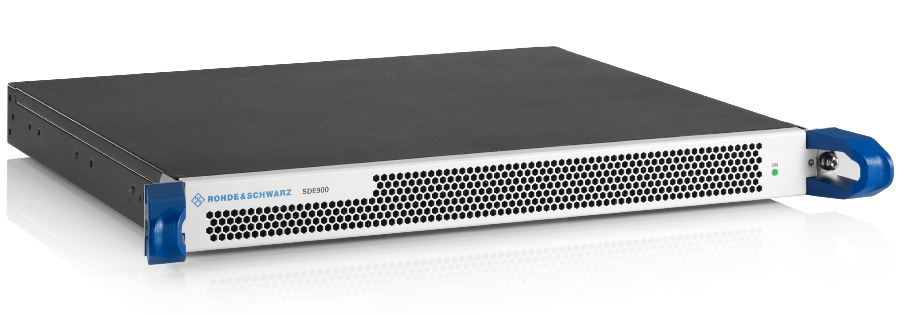2018 NAB Show Marks Next Gen TV’s Arrival
LAS VEGAS—The world’s newest digital television delivery standard, ATSC 3.0, has now come of age, getting the FCC’s official nod last November, and cheered with a champagne toast by industry leaders at the International CES. The standard, which has already been deployed in South Korea, was further showcased in February when it was used to transmit the PyeongChang Winter Olympic Games in sparkling UHD and HDR.
After years of buildup during the development process, ATSC 3.0 officially makes its debut at the 2018 NAB Show, with numerous presentations devoted to both technical and non-technical aspects of the standard, a special ATSC 3.0 exhibit, real-world mobile reception demos, and some of the first-ever ATSC 3.0-specific products on display on the exhibit floor.
THE ATSC 3.0 ’ROAD’ BECKONS
Show visitors arriving through the Las Vegas Convention Center’s Central Hall will be greeted with the ATSC’s “Road to ATSC 3.0” showcase with experts on hand to answer questions and discuss the early 3.0 deployments in U.S. television markets.

“Look for the ‘Road to ATSC 3.0’ exhibit as you enter the Grand Lobby of the Convention Center, the NAB Mobile ATSC 3.0 Shuttle in front of the complex, and various technology demos taking place in Future Park in the North Hall,” said Dave Arland, ATSC spokesperson.
Mark Richer, ATSC president, extended his own invitation to the exhibit.
“I’d encourage anyone curious about what’s coming to stop by the ‘Road to ATSC 3.0’ exhibit for an update on the Cleveland test stations, the Phoenix Model Market project, WRAL in Raleigh, and the ongoing work by Sinclair Broadcasting and others to light up ATSC 3.0 in Dallas and other markets,” he said.
The professional video industry's #1 source for news, trends and product and tech information. Sign up below.
Pearl TV, the consortium of station groups focused on developing services for Next Gen TV as well as deploying the standard, will be represented at the exhibit by Anne Schelle, managing director for the group, who discussed the next steps for ATSC 3.0.
“The industry needs to begin commercialization and develop agreed-upon industry service profiles and deployment guidelines,” she said. Last year, Pearl TV and several network partners collaborated on a Model Market in Phoenix that serves as an industry test bed for service development and consumer testing. “Details [about this] can be seen in the ‘Road to ATSC 3.0’ exhibit,” Schelle added.
A DOUBLE HIGH-TECH OPPORTUNITY
Also being featured is the NAB Mobile ATSC 3.0 Shuttle, which will await attendees just outside the LVCC. Riders will get to experience two cutting-edge technologies: ATSC 3.0 with its ability to provide rock-steady UHD television reception in moving vehicles, and a ride around the LVCC complex in an autonomous self-driving vehicle.

Sinclair Broadcast Group, LG Electronics and NAB are sponsoring the mobile demo in cooperation with Keolis, which operates the Las Vegas ‘Strip’ bus system, and the autonomous Navya shuttle, according to Mark Aitken, vice president of advanced technology for Sinclair.
“The bus route is around the parking lot and between the convention halls,” Aitken said. “The ATSC 3.0 signals viewed in the bus are being transmitted from an experimental Channel 45 installation located south of Las Vegas on Black Mountain, which is being operated by Sinclair’s KSNV.” (These 3.0 transmissions can also be viewed at the ATSC exhibit.)
[ATSC 3.0 Transition Strategies]
In addition, according to Aitken, ONEMedia/Sinclair will demo ATSC 3.0 at the Wynn, in conjunction with South Korea Telecom, showcasing dynamic ad insertion and the synchronicity aspects of ATSC 3.0 running on MMT.
TRANSMISSION CONSIDERATIONS
With many broadcasters preparing to deploy the Next Gen TV standard, plenty of exhibitors will debut new equipment, offer demonstrations and provide advice.
At minimum, the 3.0 move will involve transmitter plant changes, and there’s plenty to check out in this area.
GatesAir will show its Maxiva range of ATSC 3.0-ready transmitters, including the ULXTE for high-power UHF, UAXTE for low-to-mid-power UHF, and VAXTE low-to-high power transmitters across low and high-band VHF, according to Rich Redmond, the company’s chief product officer. “All are outfitted with our Maxiva XTE software-defined exciter,” he said.
Redmond added that broadcasters wishing to move to 3.0 may need to consider a new transmitter, even if their ATSC 1.0 DTV transmitters haven’t reached end of life status.
“The ATSC 3.0 digital waveform has a higher peak-to-average ratio than ATSC 1.0, which limits some transmitters’ capability to achieve the same power levels in ATSC 3.0 you can in ATSC 1.0,” he said.
Hitachi-Comark is ready to equip broadcasters with everything needed to produce the sparkling true-to-life video delivered by ATSC 3.0, according to Joe Turbolski, director of sales operations at the company. In addition to transmitters and an ATSC 3.0 exciter, the Hitachi Kokusai Group, in conjunction with key partners, will offer a complete “glass-to-glass” 3.0 technology demo, allowing broadcasters to visualize ATSC 3.0’s full capabilities.
“‘Glass-to-glass’ refers to the demo’s scope, which includes image capture via Hitachi HD-HDR cameras, software-based HEVC encoding, and finally ATSC 3.0 RF transmission, reception, and monitoring,” Turbolski said.

Rohde & Schwarz will launch what it says is the world’s first IT server-based exciter solution for ATSC 3.0 broadcasting according to Erik Balladares, vice president of the company’s U.S. broadcast and media division. The R&S SDE900 “was developed around a pure software-based approach, which will ensure that future evolutions of the standards are supported, and provide the most flexibility to broadcast network operators,” he said.
Updates on the testing of single frequency networks for ATSC 3.0 in the Dallas area will be discussed at the NAB Show and stations considering deploying SFNs may want to explore new antenna technologies in the Central Hall and outside exhibits.
Martin noted that broadcasters selecting Dielectric antennas for the ongoing repack won’t have to worry about another such purchase when transitioning to 3.0, as the “FutureFill” feature is built into the company’s repack antennas and can be “turned on” as needed to enhance reception across their coverage areas.
Jampro will be on hand with its “Futurization Technology,” which the company says is “based upon years of proven use by one of the largest broadcast network operators in the world.”
The company’s JUXD broadband panel targets broadband, multichannel applications where the polarization ratio has not been fully decided.
MONITORING THE SIGNAL
Monitoring of these next-generation signals will be an essential part of the transition, and there’s also plenty to see in this area.
Triveni Digital will have plenty of ATSC 3.0 gear at its booth in the North Hall.
“As broadcasters transition to ATSC 3.0, the ecosystem becomes more complex, increasing the chance for video and audio quality issues,” said Ralph Bachofen, the company’s vice president of sales and marketing. “Having an ultra-portable analysis platform like Triveni Digital’s StreamScope Portal II, which simplifies troubleshooting of DTV transport streams in both ATSC 1.0 and ATSC 3.0 environments, is critical.”
Triveni is also demonstrating other ATSC 3.0 analyzers and associated gear.
Qligent will introduce Vision-ATSC, a new cloud-based solution that will simplify the transition from 1.0 to 3.0, according to Ted Korte, the company’s COO. “Since it evaluates both ATSC 1.0 and ATSC 3.0 signals with the same hardware platform, broadcasters can use it to establish a baseline of ATSC 1.0 performance, and provide monitoring and oversight throughout the ATSC 3.0 transition for greater operational continuity,” he said.
The 2018 NAB Show will offer broadcasters a gateway to next-generation ATSC 3.0 television broadcasting, providing an opportunity for both learning about the technology from those professionals who helped to develop it, and for interacting with the companies who have created the equipment to deliver it. It behooves anyone interested in the future of television to spend as much time as possible in the exhibit halls and presentation rooms this year.
For a comprehensive list of TV Technology’s ATSC 3.0 coverage, see our ATSC3 silo.
James E. O’Neal has more than 50 years of experience in the broadcast arena, serving for nearly 37 years as a television broadcast engineer and, following his retirement from that field in 2005, moving into journalism as technology editor for TV Technology for almost the next decade. He continues to provide content for this publication, as well as sister publication Radio World, and others. He authored the chapter on HF shortwave radio for the 11th Edition of the NAB Engineering Handbook, and serves as contributing editor of the IEEE’s Broadcast Technology publication, and as associate editor of the SMPTE Motion Imaging Journal. He is a SMPTE Life Fellow, and a member of the SBE and Life Senior Member of the IEEE.

